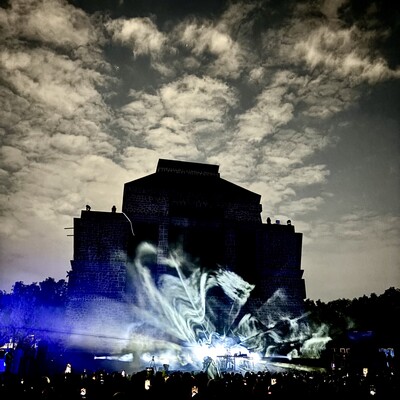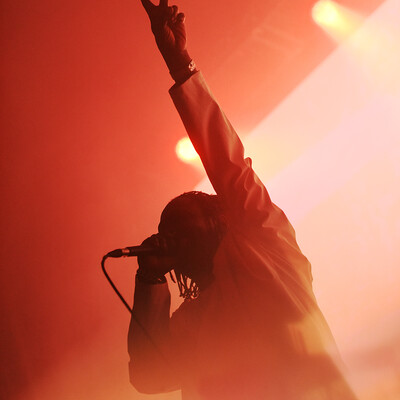Originally published on October 10, 2024 in Arquine by Emmanuel Islas Herrera
Instagram: @_emmanuel_islas
From the Tepecuícatl Concert Hall in the north of Mexico City to the Anahuacalli Museum in the south, the international digital creativity festival MUTEK MX has toured various venues across our urban landscape since 2003, where the latest in electronic music has met the avant-garde of immersive art and audiovisual experimentation.
As part of its twentieth edition, which took place from October 7 to 20, 2024, we dedicate these lines to revisiting some of the most emblematic venues. At the same time, let this reflection on the architectural site as a "third space": a liminal site between the determined and the indeterminate, the instituted and the instituting, identity and otherness, whose concretization depends on use.
What if the "third space" presupposes that architecture retains a certain "autonomy" from the formal and conceptual limits imposed on it by the plane and concrete in its time? Nothing would be predetermined in it. The mutation (MU) of the environment would carry within it the signs of the past, the present, and perhaps the future, which only the user and the artist would actualize by appropriating the space and experimenting with techniques and technologies (TEK).
In this scenario, the inevitable happens: use updates (and sometimes broadens) the horizons of meaning; it also mobilizes columns and rocks, and gives validity to what seemed frozen or immobile from the past. The proposals of meaning that occur in the "third space" include what was denied to them outside. In this way, a façade becomes an exhibition hall, or a sculptural space an open-air forum.
MUTEK seems to understand that electronic music and digital art aren't the only things that are updated through its three programs and its agenda of special collaborations. Without further ado, and once again inviting you to reflect on the relationship between users and their surroundings, we present this non-chronological retrospective of some of the festival's iconic venues during its run in Mexico City over the course of two decades.
Museo Anahuacalli
The renowned architect Juan O'Gorman once expressed his opinion of this "house surrounded by water" in the Pedregal region, south of Mexico City, whose construction began in 1945, designed by the painter Diego Rivera. The artist affirmed that, in addition to being beautiful, this construction vindicated the true value of architecture as a visual art that should produce extraordinary aesthetic pleasure:
It fell to a painter, O'Gorman said, not by chance but by the very logic of events, to reveal to us what should be as clear as daylight [...] one cannot be an architect properly speaking without being a painter and a sculptor, or vice versa, one cannot be a painter or a sculptor without being an architect, since in reality the need for efficient visual form is involved.
The Anahuacalli Museum, which celebrated its 60th anniversary on September 18, has become one of MUTEK's iconic venues. In 2022 and 2023, this volcanic rock temple hosted the A/Visions program. William Basinski, Marina Herlop, Hatis Noit, and Kazuya Nagaya are some of the most renowned musicians who have performed at the Museum. Could we see other "efficient plastic forms" in stone through audiovisual interventions in the space by 2024?
Espacio Escultórico of the Universidad Nacional Autónoma de México (UNAM)
It was the circular ruins of the Cuicuilco pyramid that inspired the form of Mathias Goeritz's Espacio Escultura. Later, the circle became a 120-meter-diameter ring, and the ring allowed the sacred to flourish at its center. In this "walkable sculpture," there is an inside and an outside, the sacred and the profane, the divine and the mundane: the cosmos and the earth. Some have seen in its 64 hammered concrete modules a reference to the 64 possible combinations of the eight basic signs of the I Ching, or Book of Changes (MU). The environment radically changed when, in 2016, a new building for the Faculty of Political and Social Sciences (FCPyS) disrupted the visual harmony of the landscape.
Be that as it may, the artist Manuel Felguérez once said that the group of sculptors aimed to create a great collective work that, aspiring to anonymity, would overcome any egocentric individualism. Could they have imagined that, over time, one possibility for their "urban art museum" would be to become an open-air forum for experimentation with electronic music, ambient music, audiovisual installations, and soundscapes by prominent artists like Robert Henke?
Teatro de la Ciudad Esperanza Iris
It is well known that the "Donceles girls" were Xavier Villaurrutia and Salvador Novo. However, there was one more who could have been their patron saint: the actress Esperanza Iris. Between 1917 and 1918, the diva built her own theater (and a house) on Donceles Street, in Mexico City's Historic Center. By that time, major political events had already taken place in a theater: the Aguascalientes Convention, the signing of the 1917 Constitution.
Esperanza Iris once said of the building: “My house is a museum […] all the money I collected in the countries I traveled around the world was used to build this theater, the Gran Teatro Esperanza Iris, where I have an apartment to live in, because I never want to leave here because this place contains—and unites with my glory as an artist—all my sacrifices, all my sorrows, and all my memories.”
In the years to come, Esperanza Iris's museum, apartment, and theater would welcome the avant-garde not only of the performing arts and opera, but also of cinema, music, and, later, of art and audiovisual experimentation. Hundreds of artists from around the world would test themselves in the neoclassical venue, as Patti Smith did recently on March 1 of this year. More than 100 years after its inauguration (it served before the Palacio de Bellas Artes!), its continued existence as a theater, forum, and cinema seems unquestionable. And although it's no longer an apartment, in some ways it's still a home.
Ex Teresa Arte Actual
This museum was also a house in Mexico City's Historic Center. Its owner, Don Juan Luis de Rivera, gave it to the Discalced Carmelites in 1616, who, over the years, built a church and a convent there. For two and a half centuries, the site served as a temple for this religious order. But it also served as a prison during the independence years, where Josefa Ortiz de Domínguez was imprisoned. Later, after the Reform Laws, the nuns were expelled, and in the early decades of the 20th century, the church and chapel of Our Lady of Saint Teresa were closed.
Today, the Ex Teresa Arte Actual (Ex Teresa Arte Actual) bears in its name four centuries of ellipses: a barracks, a school, and the printing workshops of the Official Gazette of the Federation. The Chamber Orchestra of Fine Arts and the Mexican Choir rehearsed there in the 1990s. Curious twists and turns of the string: what was originally a courtyard where Sor Inés de la Cruz and Sor Mariana de la Encarnación played and sang, currently promotes the most experimental currents of art, such as those of artists Sissel Wincent and Mexican Camille Mandoki, who performed at the fifteenth edition of MUTEK.
Domodigital of the Papalote Museo del Niño
In his biographical work, Flor de juegos antiguos (Flower of Ancient Games), Agustín Yáñez reminded his contemporaries what it once meant to be a child playing in the provincial streets of a post-revolutionary Mexico without cobblestones or sidewalks. Around the 1930s, nothing was more coveted than a bicycle, as Ricardo Garibay confessed in his childhood memoirs. And John Cheever, although from a different perspective, also left his testimony of his early years: “Children face a sea voyage with a toothbrush and a teddy bear; to travel around the world, they pack a pair of mismatched socks, a seashell, and a thermometer; books, stones, and pheasant feathers.”
Today, children could make the same “sea voyage” or beyond the land through an immersive projection in the Papalote Museo del Niño's Digital Dome, one of Ricardo Legorreta's best-known works. Eight projectors with powerful luminosity and a laser light source project all kinds of images onto a hemispherical screen measuring 23 meters in diameter and 13 meters high at its highest point. Together, they offer a field of vision of 360 degrees, extending to infinity.
Although the Domodigital doesn't carry a centuries-old history like the Ex Teresa Arte Actual, nor does it depict Fame or Glory on its facades, like the Teatro Esperanza Iris, it somehow has the ability to remind adults what it meant to be a child yesterday, and perhaps relive, through awe, certain emotions or sensations. Perhaps for this reason, the Domodigital has hosted the A/Visions +1 program in several editions of MUTEK.
Other equally iconic and noteworthy venues include the Frontón México, the Museo Tamayo, the Universitario de Arte Contemporáneo (MUAC), the Centro Nacional de las Artes, the Centro de Cultura Digital (CCD), the Chapultepec Museum of Natural History, the Siqueiros Art Gallery, and the now-closed Foro Normandie. This year, MUTEK will collaborate with two new venues: the UNAM's Casa del Lago in Chapultepec Park, and the Cultural Center of Spain in Mexico (CCEMx) in the Historic Center.
After all, what would any environment be without the human relationships that give it life and relevance?
Planning and instinct: this is how the immersive experience was created during the Circle of Live set

MUTEK MX 21: Renewing is returning to the essentials

Dance - Discovery - Immersion: three keys to an unmissable evening

Gastronomic Route MUTEK MX 21









